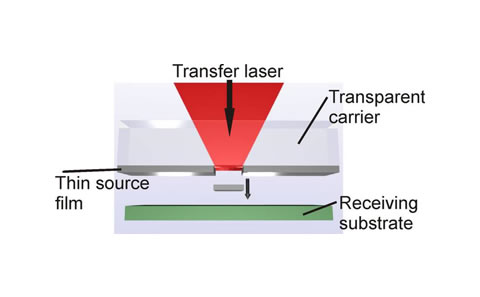
Laser-Induced Forward Transfer
The Laser-Induced Forward Transfer (LIFT) group is led by Prof. Rob Eason. The group’s interests span the complete range of the LIFT technique from fundamental studies to applications driven device development.
Fig. 1 – Schematic of the LIFT process.
LIFT involves the pixellated transfer of material from a thin film coated onto the rear side of a transparent support substrate. Transfer is induced by focussing one or more laser pulses onto the support-film interface, where heating and phase change of the film provide the propulsion to propel material to a receiving substrate placed nearby. The technique is particularly interesting due to its simplicity and versatility for micropatterning of a range of materials onto unconventional substrates and geometries.
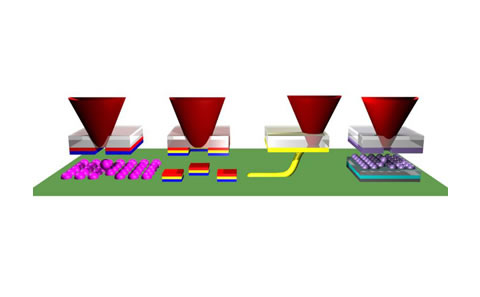
Fig. 2 – Illustration of the kinds of compound structures that can be easily produced with LIFT.
The group is very active in a number of areas relating to LIFT. We collaborate with groups both within the university (in the ORC, Electronics and Computer Science, Physics and Astronomy, and Maths), and across Europe (in Belfast, Athens, and Switzerland). Our work is primarily based in the ORC’s FAST lab facility at the moment, investigating what is achievable with LIFT using femtosecond duration pulses. With the arrival of a nanosecond-pulsed excimer laser in Autumn 2009, the research focus will expand to include nanosecond vs. femtosecond LIFT comparative studies and an increased focus on real-world devices in collaboration with local industrial partners.
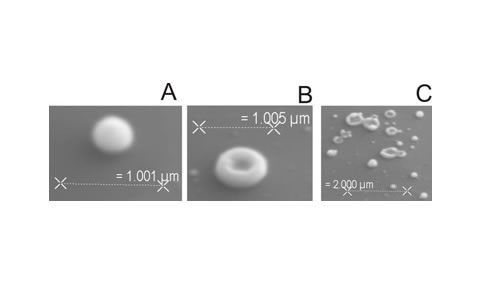
Current active research areas include:
- Obtaining ever smaller structures - The group currently holds the published world record for the smallest features produced using LIFT: 300nm diameter Cr nanodroplets.
- David P. Banks, Christos Grivas, John D. Mills, Ioanna Zergioti, and Robert W. Eason, “Nanodroplets deposited in microarrays by femtosecond Ti:sapphire laser-induced forward transfer,” Appl. Phys. Lett. 89, 193107 (2006).
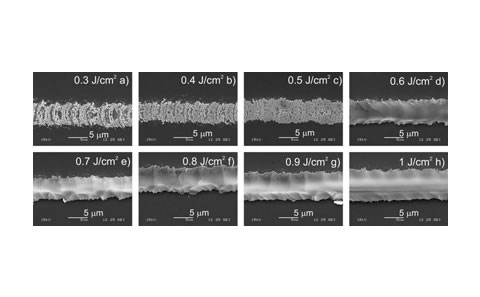
Fig. 3 – SEM micrographs of the smallest structures ever produced with LIFT.
- Transferring intact material – Keeping the transferred material intact after printing so that it is useful for real-world devices is not trivial. A main focus of the group’s work is concerned with developing methods for intact transfer. Two novel forward transfer processes, Ballistic Laser-Assisted Solid Transfer (BLAST) and Laser-Induced Solid Etching (LISE), have been developed within the LIFT group to address this issue.
- David P. Banks, Christos Grivas, Ioanna Zergioti, and Robert W. Eason, “Ballistic laser-assisted solid transfer (BLAST) from a thin film precursor,” Opt. Express 16 (5), 3249-3254 (2008).
- David P. Banks, Kamal S. Kaur, and Robert W. Eason, “Etching and forward transfer of fused silica in solid-phase by femtosecond laser-induced solid etching (LISE),” Awaiting publication in Appl Surf. Sci.
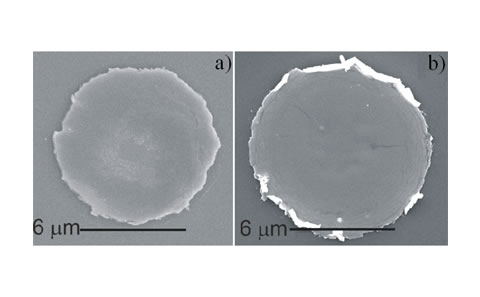
Fig. 4 – Lines of fused silica deposited onto a Si wafer by LISE.
- Transferring transparent materials – Many technologically important materials are transparent at common laser wavelengths (visible-IR). This makes them difficult to print by direct laser irradiation. However, very high intensity femtosecond lasers can be absorbed (nonlinearly!) by transparent materials. The group has the only published report of transfer of transparent materials by multi-photon absorption of femtosecond laser pulses.
- David P. Banks, Kamal Kaur, and Robert W. Eason, “Influence of optical standing waves on the femtosecond laser-induced forward transfer of transparent thin films,” Appl. Optics 48 (11),2058-2066 (2009).
- D.P. Banks, K. Kaur, R. Gazia, R. Fardel, M. Nagel, T. Lippert, and R. W. Eason, “Triazene photopolymer dynamic release layer-assisted femtosecond laser-induced forward transfer with an active carrier substrate,” Europhys. Lett. 83, 38003 (2008).
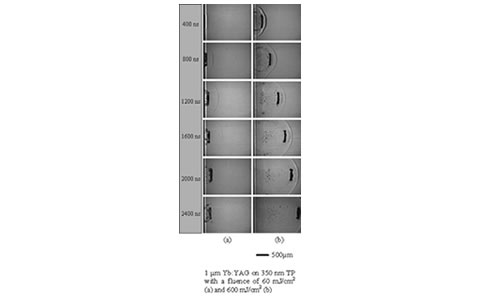
Fig. 5 – Optically transparent gadolinium gallium oxide LIFTed with femtosecond pulses.
- Fundamental studies – As with any process, a detailed understanding of the underlying physics is essential if research time is to be allocated wisely and the results are to be optimised. The group is active in the area of time-resolved imaging of the LIFT process. This work is currently done in collaboration with researchers in Switzerland, but an in-house setup is also currently under construction.
- K.S. Kaur, R. Fardel, T. C. May-Smith, M. Nagel, D. P. Banks, C. Grivas,T. Lippert, and R. W. Eason, “Shadowgraphic studies of triazene assisted laser-induced forward transfer of ceramic thin films,” Accepted by J. Appl. Phys.
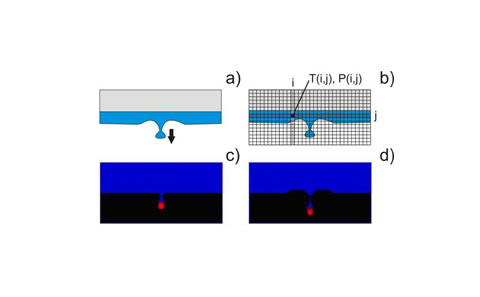
Fig. 6 – Time-resolved shadowgraphs of LIFT of ytterbium: yttrium aluminium garnet.
- Modelling – LIFT is a highly complex process and little work exists in the literature on modelling of the technique. The group is currently collaborating with several applied maths groups around the UK in this area.
- Xu Xu, David P. Banks, Robert W. Eason, Stephen P. Banks, “Cellular Modelling of the Laser-Induced Forward Transfer of Micro- and Nano-Scale Droplets,” to be presented at the 5th International Congress on Laser Advanced Materials Processing (LAMP), Kobe, Japan, Jun-Jul 2009.
Fig. 7 – Schematic and results of cellular model of nanodroplet transfer by LIFT.
Key research breakthroughs:
We have recently proposed and demonstrated the use of ultrafast Laser-Induced Forward Transfer (LIFT) as a rapid prototyping method for the fabrication of waveguides in nonlinear optical material such as lithium niobate. Direct laser printing of predefined titanium metal patterns followed by the thermal in-diffusion of the deposited metal was used to fabricate titanium in-diffused channel waveguides and X-couplers with propagation losses as low as 0.8 dB/cm. Details of this simple and novel lab-based waveguide fabrication process are presented in the following journal article that is available online with the journal Applied Physics A Materials Science and Processing
Laser-induced-forward-transfer: a rapid prototyping tool for fabrication of photonic devices
C. L. Sones, K. S. Kaur, P. Ganguly, D. P. Banks, Y. J. Ying, R. W. Eason and S. Mailis.
Research Facilities:
Our work is primarily based in the ORC’s FAST lab facility at the moment, investigating what is achievable with LIFT using femtosecond duration pulses. With the arrival of a nanosecond-pulsed excimer laser, the research focus has expanded to include nanosecond vs. femtosecond LIFT comparative studies and an increased focus on real-world devices in collaboration with local and European academic and industrial partners.
Collaborations:
Internal (ORC and UoS):
• Electronics Systems and Devices Group, ECS
• Energy Technology Group, SES
Academic:
• CNRS, Laboratoire Lasers, Plasmas et Procédés Photoniques Campus de Luminy, Marseille Cedex, France
• Paul Scherrer Institute, Switzerland
• National Technical University of Athens
• EMPA - Swiss Federal Laboratories for Materials Science and Technology
• CNR Instituto Di Acustica E Sensoristica O M Corbino, Italy
• ARMINES/EMSE – CMP-GC, France
• National Institute for Laser, Plasma and Radiation Physics, Romania
Industry:
• Laser Micromachining Limited, UK
Work with us
If you would like to find out more about our LIFT group or would be interested in working with us please contact Professor Rob Eason.
Group members
No members in database.